M. Isidora Forrest's Blog, page 5
March 4, 2025
Join Me at Spirit Northwest
Hello, all!
This is for those of you in the greater Pacific Northwest.
I’m excited to be one of the presenters at Spirit Northwest, a new conference for “Paganism, witchcraft, and natural magic” being held in Portland, Oregon. The conference is May day weekend: May 1-4, 2025.

One of the things I am loving about SPW is that they’re scheduling longer presentations—not just 45 minutes. That means we can really get into some depth with the topics. So you better believe I applied for one of those 2-hour spots asap.
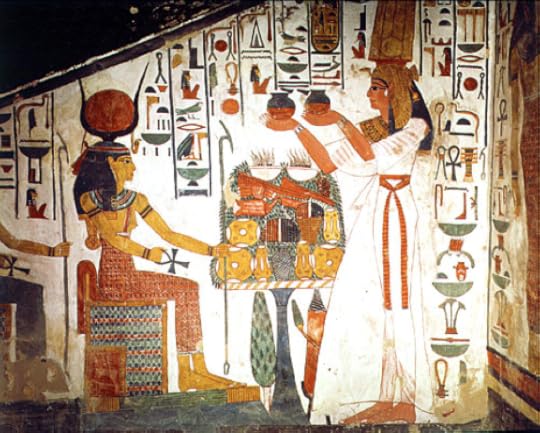 Nefertari making offering to Isis
Nefertari making offering to IsisI’ll be there on Saturday, but the event goes from Thursday evening through Sunday afternoon. Check out the website here. And the whole schedule here. Rituals! Learning! Meeting new folks!
Since we have the time, for my presentation, we’ll be both talking together AND a doing a ritual. It’s called “Under the Wings of Isis: the Greater Mysteries of Making Offering.”
So first, we’ll talk about the traditions and techniques of ancient Egyptian offering rites—going into some depth about how offering really works—then we’ll participate together as we “Open the Ways” to Isis and make offering to Her, receiving Her magic and protection in return.
We’ll be doing the talk part “Hermetic Society” style, meaning that you can ask questions and make comments during the talk. It’s a bit more chaotic, but it’s also more fun, too, for me and for you. And yes, this will be a presentation with pretty pictures, because who doesn’t like to look at pictures?
 A couple making offering
A couple making offeringI wanted to let you know about this a bit early so there’s time for budgeting 
And here’s some more good news: the second edition of Offering to Isis, Knowing the Goddess through Her Sacred Symbols should be/will be out by the time. It’s available for pre-order now here or click on the book cover in the sidebar.
In fact, it’s being printed even as we speak and I hope to have some books with me (fingers crossed) for the conference.
Your hosts for the conference are the creators of That Witch Life podcast, so do have a listen.
If you’re in the area, I hope you’ll come join us!
March 2, 2025
A Meditation within the Heart of Isis
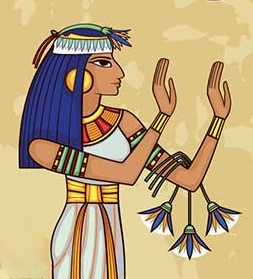
The spring equinox approaches. Okay, I’m anticipating…just a tad. But winter is ending. And we continue both our work in the world and our Great Work within.
Today I’d like to share a meditation from Isis Magic, slightly modified, which I hope may offer some hope and strength. You may, as I do, find it a little challenging right now—because it opens up space for gratitude, yes, even in this terrible time.
Where to do the meditation is up to you. In front of your altar is always good or, if the weather is clement enough, outside might be even better—for we can sometimes sense Isis’ heartbeat more easily in nature.
We start with the Wings and Breath of Isis. We invoke and connect with Her as we sense Isis’ mighty heart. With our own hearts opening, opening to Her, we give voice to things for which we are grateful—anything from the warm scent of cat fur to the beauty of the day to the love of our friends and activities of our communities. And try to actually speak these gratitudes out loud if you can. The power of heka, magic, is in the word—and this is intensified when spoken.
I hope you will join me in this meditation as we begin to welcome the light of coming spring.
The Wings & Breath of Isis
Stand, with your arms at your sides, facing east. Inhale while simultaneously bringing your hands together at the level of your abdomen and cradling one palm in the other. With this breath, be aware that you are gathering strength. Exhale while simultaneously raising and spreading out your arms like wings unfurling. The arms should be slightly curved, with the palms facing out and slightly above the shoulders. With this exhalation, be aware that you are expending your personal energy to reach out to Isis. Breathe in and say:
“I am a Child of Isis. I am a Beloved of the Goddess.” (Repeat this as many times as you need in order to feel that it is so.)
Now turn your palms inward, forming a cup with your arms. Inhale and imagine you are drawing in the breath of Isis and it fills the cup of your arms. Exhale and open out your arms, allowing them to slowly arc down to your sides. As you exhale, imagine sharing the blessings of Isis with all the earth. To complete the sign, return to the first position.
Greeting the Goddess
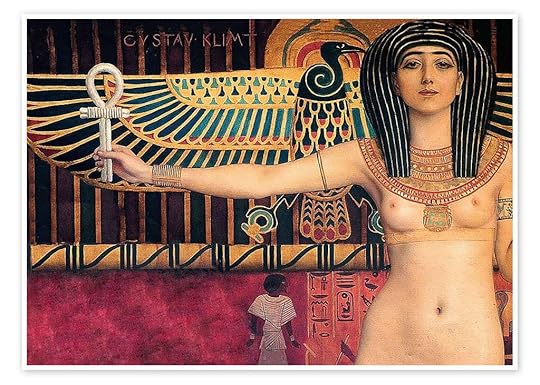 Detail from Ancient Greece and Ancient Egypt by Gustav Klimt
Detail from Ancient Greece and Ancient Egypt by Gustav KlimtBe seated comfortably, breathe, and begin chanting Her name. You may use any of Her epithets you like. (Maybe even try some from last week’s post?) Or simply chant Her name as Isis or Iset or Ise. When you sense Her presence, stop. Breathe deeply and slowly. Know that you are breathing the breath of Isis the Goddess. Try to match your breath to Her breath.
Heart Joined to Heart
Now, begin to sense Isis’ heartbeat. It is within Her and it is all around you. Listen to Her beating heart. Her heartbeat is in all things. In the breath of the sky. In the song of birds. In the wind moving through grass and trees. In the flowing of the waters. In the thrumming of the great, deep Earth.
Listen and find the rhythm of the heartbeat of Isis, the Great Goddess. Become very aware of that rhythm.
Now, become aware of your own heart—awakened and alive and open to Her within your body. Place your finger on your pulse if need be to feel the heartbeat of your own life.
Now see if you can attune your human heart to the rhythm of Her Divine and Living Heart. Let it slow or speed to meet Hers. Attune your heart to Hers until you sense the two hearts beat in harmony.
Read the following aloud, speaking these Words of Power, and taking time to confirm the truth of these potent words in your heart:
“My Mother. My heart. My Mother. My heart.
“I am aware in my heart. I am in power in my heart. I am aware and in power in my heart, which is the heart given to me by my human mother—and by my Great Mother Isis.
“My Mother. My heart. My Mother. My heart.
 A Klimt-inspired Isis work by Brightstone
A Klimt-inspired Isis work by Brightstone“I am intelligent in my heart. I am compassionate in my heart. I am intelligent and compassionate in my heart, which is the heart which drums in rhythm with the heart of Isis, the Radiant One.
“My Mother. My heart. My Mother. My heart.
“I am alive in my heart. I am full in my heart. I am alive and full in my heart, the center of all Being, the beginning of all Becoming. I am alive and full in my heart, and my heart knows all the joys of my life.
“In the fullness of my Being, I am Becoming joy-full. The Star of Isis arises—all will be well. Isis comes—peace returns to me. I am sitting in the Throne of Abundance bathed in Her Light. Once again, I attune my human heart to Her Divine heart.”
Thanksgiving
Close your eyes and open your heart. Know you are protected by the wings and centered in the heart of Isis. Then name aloud some things you are grateful for. Don’t stress if nothing comes to mind right away. Just wait patiently. When you’re ready to name them, say:
“I am grateful for (naming as many things as you can).”
When you have completed your thanksgiving, say:
“My Mother. My heart. My Mother. My heart. I am aware in my heart and I am grateful in my heart. You have blessed me, Isis, and I am thankful, Great Goddess, in return. Amma, Iset. Grant that it ever be so.”
Complete the meditation by rising and working the Wings and Breath of Isis one more time.
 Egyptian heart amulet, made of carnelian; “My Mother, My Heart”
Egyptian heart amulet, made of carnelian; “My Mother, My Heart”
February 23, 2025
Hymns to Isis of 10,000 Names from Denderah
One thing I learned from our Egyptian visit to the Great Temple of Hathor at Denderah, is just how very, very, very present Isis is in this entire temple complex.
 Approaching the Temple of Hathor at Denderah
Approaching the Temple of Hathor at DenderahI knew that, just as Hathor has a small temple at Isis’ great Philae sanctuary, so Isis had a small temple at Hathor’s great sanctuary at Denderah. But I didn’t know how present Isis is within Hathor’s temple itself.
 The remains of the Isis temple at Denderah
The remains of the Isis temple at DenderahSo, today I’d like to share with you some of the praises and epithets of Isis found within the great Hathor temple. They can be used and/or adapted through your own creativity for ritual use. The translations come from Egyptologist Sylvie Cauville’s Dendara: Hymnes à Hathor et à Isis. So they are my English translations (with help from Google Translate) of her French translations of the hieroglyphs. I’m awaiting an interlibrary loan of her book on all the texts from Isis’ small temple at Denderah. I’ll share those with you in the future.
But for today, let’s look at some of the ways Isis was understood at Denderah. Since most of the remains at Denderah are Ptolemaic, we won’t be surprised to find Isis expressing Herself there in many of Her ten thousand names. Here’s an example:
Isis the Great, Mother of the God, Mistress of the Birth Mound, Who takes Her place in Heliopolis, Lady of the Beginning of the Year, Queen of Messengers, Who appears at the New Year to open the Beautiful Year. [She is] Amunet (the Goddess counterpart of Amun) at Thebes, Menhit (a Lioness Goddess) in Heliopolis, Renpet (“Year”) is Your name in Memphis, Sothis (Sopdet, the Star Goddess) in Elephantine, Hededyt (a Scorpion Goddess) in Edfu, the Venerable Vulture (the Goddess Nekhbet), the ruler of Hierakonpolis (Nekhen), [She is] the Heliopolitan One in Heliopolis, Daughter of Nuet, brought into the world in the Birth Mound on the beautiful day of the Child-in-His-Nest, the One Who takes flight again towards the sky; Heqet (the Frog Goddess) in Abydos, Seshat (the Scribe Goddess) in Hermopolis, Djedet (“Word” or “Great Word,” Djedet Weret) is Your name in Busiris, the Mysterious One in Bubastis, Ipyt (a Hippopotamus Fertility Goddess) in Pe, Depet (“the One of Dep”) in Dep, Neith in Sais, Wadjet in Nebecheh (the location of a temple of Wadjet), Hathor in all the land. She is the One Who dwells in every city and in every nome with Her son Horus and Her brother Osiris.
Those of you who have seen the will recognize this format: give Her name and then the place in which She is called by that name (or vice versa).
“Isis of 10,000 Names” from the Isis Oracle; art by Jim MantonOn one of the pylon doorways at Denderah, where both Goddesses are invoked, we learn this of Isis’ power:
She is the Sovereign of the Palace, the Ruler, the Mistress of Writing. She announces what will happen in the future. Life is in Her hand, health is in Her fist, one does not oppose what comes from Her mouth. She takes care of the one who is not unfaithful to Her and defends the one She loves on the day of the “fight in the arena” (I assume this means during challenging times; but I supposed it could be something more specific, too). She is the irreproachable protector of those who have nothing and those who have everything. What She conceives happens forever. She comforts the unfortunate with Her word at the closing gate. She is Seshat the Great, the Primordial, the First Who Inaugurated Writing, the First Who is Brought into the World Among the Goddesses.
On the doors of the “Mysterious Corridor,” Isis is praised as the Powerful One. Re is said to shine in the horizon (akhet) when He sees Her and human beings come to Her to make Her heart joyful. In the Isis Chapel within the Hathor temple, She is called by many of the titles we have already seen, but She is also the Queen of Egypt in its Entirety, the Great One in Heaven, the Powerful One on Earth, the Primordial One Who Created the First Time (Zep Tepi) and All Good Things—which She shares with those She loves. She “dispenses the Commandments in the places of worship.” What must happen “happens when You [Isis] order it.” She is “excellent and beautiful.” She is “the Female Ibis Without Her Equal, the Mistress of Writing, the Sovereign of the Library.” She is the ruler of the orb of the sun and of the stars. As Sothis, She is the One Who Brings the Flood to “create life for the living.” She is the Eye of Re and the Unique Uraeus serpent.
 Isis of Corinth by Stuart Littlejohn; purchase a copy here; I have my copy, just gotta get it framed
Isis of Corinth by Stuart Littlejohn; purchase a copy here; I have my copy, just gotta get it framedShe is also called Horet, the Female Horus. Her favors to Her devotees are great as is Her love. She is the Hand of God with inexhaustible benevolence. And Her true name is Isis (but also The Golden). This is very reminiscent of Apuleius’ aretalogy of Isis in which the Goddess lists many of the names by which human beings know Her, but finally states that Her true name is Queen Isis.
Quite a few of the Isiac hymns in the Denderah temple repeat many of the epithets we’ve already seen, so I’m trying to pick out the ones I find interesting and that I think you may also find interesting.
For instance, epithets from the Denderah Chapel of Water and Chapel of the Crown call Isis the Great Oracle Who Arrived at the Beginning and the Oracle Who Announces What Will Happen in the Future. These would be perfect epithets to use when reading Tarot or using another divination system under Her auspices. The Chapel of Water also says that She makes the Inundation flow to “invigorate the hearts of the Guardian Gods;” so another protective function. Her Ka is praised and She is called the Living Ba. She is the Lady of East, South, West, and North.
 Isis the Magician, according to WordPress AI
Isis the Magician, according to WordPress AIIn the Chamber of Fabrics, Isis is identified with Tayet, the Weaving Goddess. The text says that the Divine Fabric is made for Her Ka and that She is Mistress of the White, Green, Purple/Blue, and Red fabrics.
One of the things especially celebrated at Denderah is the birth of Isis. Her birth is connected to the epagomenal days when She rises as Sirius before the sun to mark the New Year.
In the Chapel of the Sistrum, it is said that Isis “took possession of the royal office even before She left the womb; She ruled the throne from Her swaddling clothes.” I’m guessing we’ll learn more about Her birth when I get that interlibrary loan of the texts from the small Temple of Isis.
Isis the Magician, according to Roman-era EgyptOn the exterior temple walls, Isis is said to be born “in the form of a black-haired woman, full of life, Sovereign of the Ennead, Ruler of Magic.” More of Her ten thousand names are added in the pronaos of the temple: She is Amunet, Menhit, Renpet, Sothis, Nekhbet, Tanenet (a Goddess of brewing and childbirth), the Heliopolitan One, Isis, Seshat, Heqet, and Wadjet. She is also the One Who Loves the Embrace, the Mistress of Life, Tayet, She Who Hears Everything, the Mysterious, Pyt (possibly a variation or misspelling of Ipyt), Depet, Neith, Khensyt (a Goddess of the royal crown), and Isis in every nome. She is the Mistress of Offerings, the Feminine Disk (of the sun), Mistress of Bread, Who Prepares Beer, and Lady of Exultation and Joy. She is the One Who is Rejuvenated in the Faiyum, Mistress of Life in Metenou (couldn’t find out where that is). In Mendes, She is the One Who Speaks. In Busiris, She is the One Who Hears Everything. And She is still The Mysterious in Bubastis.
The pronaos also notes that on the birthday of Isis, joy breaks out in Denderah and in Edfu. (Remember that these two temples are connected by the love connection between Hathor and Horus.) Heavenly Nuet gives birth to Isis—the Scholar for the Ennead—so that She may give birth to Horus the Avenger. The text says that Isis “was initiated into Wisdom as the Great One” and that the Goddesses come to see Her birth, wearing the menat-necklace and bearing the sistrum, “to appease the heart of The Magician (that is, Isis).”
That’s a lot of (hopefully) new and interesting epithets to work with for today. Any one of these epithets of Isis or Her identifications with other Goddesses would be a worthy subject for invocation and meditation.
February 16, 2025
Wandering Isis
Part 3
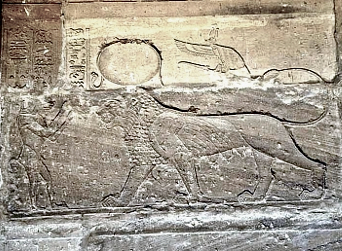 Thoth, in the form of a baboon, lures Tefnut, in the form of a lioness, back home to Her father Re
Thoth, in the form of a baboon, lures Tefnut, in the form of a lioness, back home to Her father ReLet’s finish up our exploration of Isis as a Wandering Goddess by looking at some additional ways Isis’ story fits in with the myth of the Wandering/Distant/Returning Goddess. Last time we saw how Isis’ lioness form and the raped-Goddess theme fit in with other Wandering and Distant Goddesses, as well as how prevalent that myth was in the Delta—the place where Isis’ worship most likely originated.
So let’s see what else we can find out.
Eye of Re
 The fiery Eye of Re
The fiery Eye of ReIn addition to being fierce and protective Lioness Goddesses, our Wandering Goddesses are also fierce and protective Eye Goddesses. Usually, They are Solar Eyes—Daughters of Re—hence Their fiery nature—though we saw that the Lioness Goddess Mehyt may be associated with the Udjat Eye, the full Lunar Eye, which in turn connects Her with the ever-so-famous Eye of Horus, son of Isis.
Isis is Herself a Divine Eye and Daughter of the Sun God Re. She is said to “emerge” from Re or “come forth” from His body. At Her Philae temple, inscriptions say that She “appears” as the Eye of Re. (On the other hand, as a Primordial Goddess, Isis is also said to give birth to Re, so there’s that.) Isis is called Re’et, the Female Re…indeed, at Denderah She is called “the Re’et of Re’ets,” that is, “Sun Goddess of Sun Goddesses,” and She is also Queen of the Re’et Goddesses. She is the Solar Eye, “the right eye of He Who shines like gold” and She is the solar disk, the Aten Itself. Hathor and Isis are the only Goddesses Who have the distinction of being identified as the solar disk itself. At Denderah, Isis is Re’et “in the dual course of the sun and the moon,” and so She encompasses both Solar and Lunar Eyes.
 Eye of Re Who has No Equal in Heaven and on Earth
Eye of Re Who has No Equal in Heaven and on EarthThe Fiery Goddess strikes fear in the heart of Her, and Re’s, enemies. Her power can cause death “in this vigorous form” and She describes Herself as “She who triumphs, the companion of Re.” As the Sacred Eye, the Goddess coils as a uraeus serpent and third eye upon the Sun God’s brow, protecting Him and fighting an ongoing cosmic battle against His great opponent, the destructive Serpent Apop (Gr. Apophis). Inscriptions from Philae call Isis “Neseret-serpent on the head of Horus-Re, Eye of Re, the Unique Goddess, Uraeus” and “Eye of Re Who has No Equal in Heaven and on Earth.”
 The all-seeing black kite
The all-seeing black kiteIn addition to being a Divine Eye, we can also understand Isis as having particularly keen sight due to Her sharp raptor’s eyes. Her most prominent sacred bird is the kite hawk, whose sky-high viewpoint gives it an advantage in being able to see far distances, which could easily lead to the conclusion that it was All Seeing. In later periods of Her worship, Isis was invoked not only as “all-seeing,” but “many-eyed.”
Isidorus’ Faiyum hymns to the Goddess describe Her as gazing down on the activities of humanity and noting the individual virtues of human beings. Yet the glance of Isis’ sharp eye can have dire consequences for those who oppose Her. When the Ennead of the Gods is arguing over whether Horus or Set should receive Osiris’ throne, the Deities back down in the face of the anger and flashing eyes of Isis.
The Goddess Leaves the Premises
The next few pieces of our puzzle, I admit, are not as strong as the argument to date. We just don’t have a surviving Isis myth that’s close to Tefnut’s or Hathor/Sakhmet’s angry departure and joyful return. My guess is that Isis became so strongly associated with the Osirian myth cycle—and there were so many other Goddesses associated with the Wandering Goddess cycle—that there simply wasn’t a need for people to retain that particular myth—if there originally was one, as I think there was—in relation to Isis.
 Isis wanders, finds each piece, and creates a shine for Osiris
Isis wanders, finds each piece, and creates a shine for OsirisAs Isis began to break away from the Goddess pack, so to speak, and Her worship spread not only throughout Egypt, but into the entire Mediterranean region and beyond, there was less and less reason to include that theme in Her worship. Instead, the very human, heart-touching emotionalism, tragedy, and eventual triumph of the Isis-Osiris-Horus myth took over…even as She was .
And yet, Isis does wander. She wanders throughout the length and depth of Egypt searching for the pieces of Her Beloved’s body. She creates shrines in the major cities and towns of Egypt, so that Her story is known by all. The ubiquity of the Isis-Osiris myth was so prevalent that the historian Herodotus, in the 5th century BCE, had the impression that Isis and Osiris were the only two Deities universally worshiped in Egypt. Not only that, but we can imagine that Isis’ wandering is filled with grief and mourning, yes, but also with anger. If you have ever lost someone suddenly, you will understand, on a gut level, that anger is a very familiar part of mourning.
Is Induced to Return
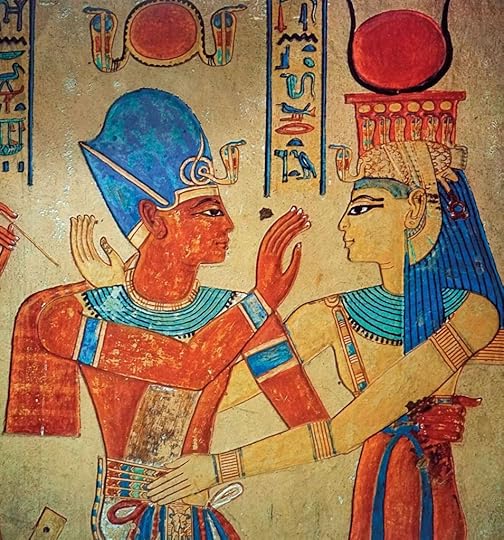 Horus takes His rightful place as king; Isis is in joy
Horus takes His rightful place as king; Isis is in joyRather than being coaxed into returning home, however, Isis is more self-directed. She returns when Her task of gathering Osiris is complete and She has guided His resurrection and transformation into Lord of the Dead. Her concerns at home now turn to ensuring Horus takes His rightful place as king. And here again we see Her demonstrate the fiery power and righteous anger of the Divine Eye. Remember what we saw above regarding the Ennead backing down in the face of Her anger.
Is Pacified (and Goes on a Boat Ride)
Backing down and admitting that Horus should indeed be king, the Ennead pacifies Isis. Ah, so Our Lady did need a bit of placation after all. What’s more, at Hathor’s Denderah temple, where the two Goddesses are so, so close, we even find that Isis needed an isheru to cool Her off.
 See the wavy lines indicating water on three sides of Her throne? That’s the isheru.
See the wavy lines indicating water on three sides of Her throne? That’s the isheru.At Denderah, Hathor and Isis often mirror each other. In the main temple, we see Hathor on Her throne on one wall and Isis on another. Beneath Hathor’s throne we see 16 vases of Inundation water, one vase for each cubit of the ideal height for the Nile flood. The king offers Her a jar of Primordial Water, while Her son Ihy plays the sistrum and rattles the menat to sooth Her anger. On another wall in the same room, we find Isis enthroned. Beneath and around Her throne are the wavy lines that indicate water in a basin shaped roughly like an isheru. The inscription identifies it as precisely that by telling us that, “Her isheru lake is all around Her.”
This same scene, the two seated Goddesses with 16 vases beneath Hathor’s throne and an isheru surrounding that of Isis, is also found in Denderah’s so-called Chapel of Purification, the Per-Nu. And yet again, the same scene of Isis alone is found on another wall in a different room of the temple. As before, the enthroned Isis is seated over an isheru-shaped basin. The inscription reads, “Isis the Great . . . is seated/pacified in the isheru that is all around Her, Who crosses the lake within Her barque.” The inscriptions go on to describe Isis’ traveling on the isheru as a meeting with Her father Nun and tell us that He enfolds Her in His arms. Both Isis and Hathor are connected with the Inundation and the Primordial Waters. The Waters are offered by the king to Hathor since She regulates the ideal Inundation, while Isis, Who brings the Inundation, is embraced by Her father Who is said to be the primordial Watery Abyss Himself.
 Detail of a fresco from the Temple of Isis in Pomeii thought to refer to the Navigium Isidis, with Isis or Her priestess in the ship
Detail of a fresco from the Temple of Isis in Pomeii thought to refer to the Navigium Isidis, with Isis or Her priestess in the shipThe Goddesses’ ritual travel by boat upon the isheru is known to Egyptologists as a navigation. (At Denderah, there were 9 navigations, by the way: one for each place the Goddess stopped on Her way back from Nubia.)
We might remember that Isis, too, has a rather famous navigation: the Navigium Isidis (the “ship of Isis” or “sailing of Isis”). I’m still trying to confirm the Egyptian word that was used for the “navigation” in the Hathor-Isis festival. There is an Egyptian word, khenet, which is related to other words having to do with boats, sailors, and navigation—as well as a festival of Osiris that featured a procession of boats—but I’m not sure whether the same word was used for the navigation of Isis and Hathor on the isheru.
 A fanciful Italian mosaic, from the Hellenistic period, showing Egypt during Inundation
A fanciful Italian mosaic, from the Hellenistic period, showing Egypt during InundationNevertheless, it is clear that at Denderah one of the things the Return of the Goddess was about was the return of the waters of the Inundation that would bring food and prosperity to Egypt. In addition, the rising river made the Nile more navigable for a wider variety of boats and ships. Just before the flood was the time of the river’s lowest, most-difficult-to-travel water levels. The Navigium Isidis (Gk: Ta Ploiaphesia; the Launching [of the Ship of Isis]), while not concerned with the water level or Inundation of the Nile, was concerned with the navigability of the Mediterranean Sea that would mark the start of the shipping season in spring.
Then Festival Ensues
 The Fierce Feline Goddess, now pacified, celebrates
The Fierce Feline Goddess, now pacified, celebratesWe now come to the final element in the Wandering Goddess myth: Her joyful return and the Festival of Drunkenness. We have already seen evidence of such festivals for Mut, Tefnut, Bastet, Nehemant, and of course, Hathor. And I’m sure that, at Denderah, with the closeness of the Goddesses, Isis devotees would have participated with Hathor devotees during the festivals held there. There certainly were joyous festivals for Isis—She is, after all, called “the Festive Goddess.” Often, these were related to the conception and birth of Horus and the birthdays of Isis and Her siblings during the epagomenal days. What’s more, She is known as a joyful Goddess; temple inscriptions call Her the Queen of Joy, Lady of Rejoicing, and Lady of Jubilation. Deities and human beings rejoice when They/they see Her. Isis is called She Whose Heart is Open and Her joy is likened to the beauty of the full moon.
Still, we don’t have solid evidence of a full-fledged Festival of Drunkenness for Isis.
And yet.
There are these two little bits of graffiti from Her temple at Philae. They’re in bad shape. They’re from a late period. But one mentions a day of singing and drunkenness, the other notes a dedication to Hathor, a “house of greeting,” and “the place of drunkenness of the people.”
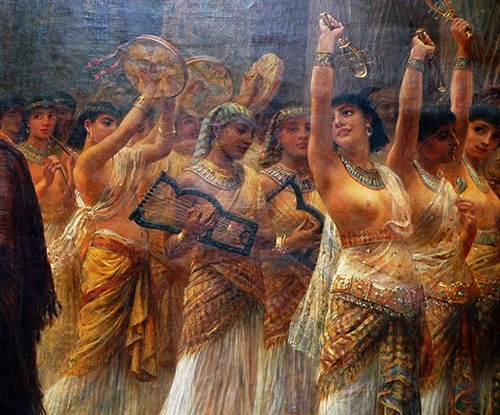 Let us celebrate the Festival of Tekh (drunkenness) that we may see the Goddess
Let us celebrate the Festival of Tekh (drunkenness) that we may see the GoddessIn fact, all of this makes sense. Philae was home to a temple of Hathor—just as Denderah included a temple of Isis. Philae was also Tefnut’s first stop on Her way back from Nubia.
It was at Philae that She changed from burning lioness to peaceful Goddess. So it may well be that—in that fluid way of Egyptian Goddesses and Their festivals—Isis-Hathor-Tefnut may have been celebrated with a Festival of Drunkenness at Philae, too. Since there is no temple calendar carved on the walls at Philae, we can’t be sure, but perhaps we will learn more from other discoveries as time goes on.
So, there you have it. It may have been that Our Lady Isis participated in both of the great mythic themes of ancient Egypt: the Isis & Osiris story as well as the myths of the Wandering/Distant/Returning Goddess.
February 9, 2025
Isis as a Wandering Goddess
Part 2
Last time, we wondered whether Our Lady Isis might be one of the Wandering/Distant/Returning Goddesses of ancient Egypt. And while we don’t have myths of an angry Isian departure or a festival of drunkenness for Her, I still think there are enough traces left to connect Isis to this important Egyptian mythic theme.
 Isis’ Philae temple, now on Agilika island
Isis’ Philae temple, now on Agilika islandLet’s start at Philae, the location of Isis’ great Upper Egyptian temple, located near Egypt’s border with ancient Nubia. As you might recall, Philae was Tefnut’s first stop upon that Goddess’ return to Egypt following Her angry flight to Nubia. An inscription on Isis’ temple there says that when Tefnut arrived, there was a great flame around Her, but then She went up into the sky 10,000 cubits and immediately became peaceful.
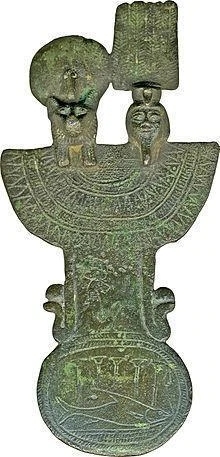 Tefnut & Shu on a menat
Tefnut & Shu on a menatEgyptologist Joachim Quack suggests an astronomical solution to the burning lioness’ aerial ascent: the heliacal rising of the star Sirius, which twinkles red close to the horizon, but as it rises higher takes on a calmer, blue-white color, and which—thousands of years ago—heralded the beginning of the vital Egyptian Inundation. The temple at Philae, in ancient Egypt’s far south, would have been one of the first places observers could have witnessed the heliacal return of the star.
 Sopdet by Yliade
Sopdet by YliadeThe star’s behavior, apparently leaving the sky for a period of about 70 days each year while it is in a too-close conjunction with the greater light of the sun, works well with the myth. The Goddess disappears for a while, then returns to the rejoicing of the people, for as She returns, She brings with Her the floods that ensure the fertility of the land. What’s more, some of these festivals for the Returning Goddess seem to have taken place around the summer solstice. Depending on when in time and where on earth you were or are, the summer solstice could coincide roughly with the rise of Sirius.
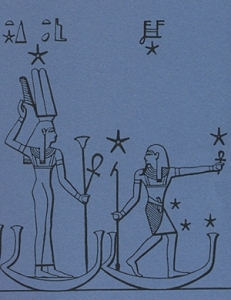 Iset-Sopdet following Sah-Osiris in Their celestial boats
Iset-Sopdet following Sah-Osiris in Their celestial boatsSo…here in Isis’ temple on the border of Nubia, we have Isis’ own grandmother Tefnut, identified with the star Sirius, which is itself personified as the Goddess Sopdet, a Goddess Who has been identified with Isis since at least the time of the Pyramid Texts. If we appreciate the Sirius solution as a possible origin for the myth of the Wandering Goddess, it’s a pretty easy, pretty clean Distant/Returning Isis connection.
Of course, if you’ve looked into Egyptian myth, you know that most of it doesn’t come in clear, narrative form. The only reason we have a narrative-ish version of the Isis and Osiris story is that the Greek priest Plutarch wrote it down like that.
As a source for the story of Tefnut as the Returning Goddess, we have the Demotic and Greek versions I mentioned last time, but mostly what we have are bits and pieces from temple walls, monuments, funerary texts, and texts like the Delta and Tebtunis mythological manuals. And while the overarching theme is the same—Goddess goes, bad; Goddess returns, good—the details are different enough that no one has tried to put together any such thing as a definitive version of the myth.
So, to track down our Wandering Isis, I’ll try to pull together some of the pieces of Her story that seem to relate to the main features of the myth/s as we know them.
 “A Fierce March” by Hiren Vekaria
“A Fierce March” by Hiren VekariaThe Angry Goddess
One of the first things you may have noticed is that our Distant Goddesses all have a lioness form. Most people are familiar with the lioness forms of Sakhmet-Hathor and Tefnut, but the other Distant Goddesses are lionesses, too. As the pride’s main hunters, lionesses are decidedly fierce. Even lions back off in the face of an angry lioness; you’ve seen the videos.
And yes, even glittery Sopdet has a lioness form. If you’ve been following along with this blog, you already know that Isis Herself can appear as a lioness and is frequently identified with Sakhmet or Bastet, just to name two of our most prominent Feline Goddesses. Isis’ Philae temple entrance is guarded by two lion statues and She is often shown seated upon a lion-throne.
Horit (read about Her here and here) is lioness connected, too. Like Isis, She is repeatedly identified with some of our fierce feline Goddesses. One of Her children is killed by a lioness. The lioness is hunted down by Nephthys and Thoth and flayed. The remains of the child are wrapped in the lioness’ skin and the child is reborn.
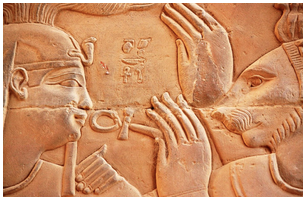 Isis with the head of a lioness from the Kom Ombo temple
Isis with the head of a lioness from the Kom Ombo templeAnother part to Horit’s myth makes Her a duplicate of Isis. One of the children She bears to Osiris is Horus of Medenu. When Osiris is killed by Seth, Horit hides Her Horus in the marshes, raising Him to be an avenger of His father Osiris—just as Isis did with Her Horus, Harsiese “Horus, son of Isis.”
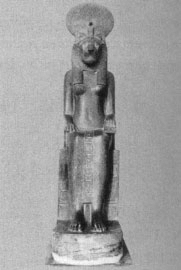 Nope, not Sakhmet. It’s Isis.
Nope, not Sakhmet. It’s Isis.Further, Horit is imprisoned in Sebennytos where She is connected with Tefnut, Sakhmet, Bastet, and Hathor. Sebennytos also had a temple of the lioness Meyht and Her consort-hunter Onuris. Just a few miles from Sebennytos is the location of the Lower Egyptian temple of Isis known (later) as Isiopolis with its focus on the resurrection of Osiris. So right here, in this part of the Egyptian Delta, we find temples and myths that incorporate both the Returning Goddess and Isis-Osiris themes. What’s more, we have a duplicate Isis—Horit—Who forms a kind of bridge between these two important motifs.
 Bastet as lioness rather than cat
Bastet as lioness rather than catAnother characteristic of our Distant Goddesses is that They are angry when They leave. In some cases, we know why; in others, we don’t. And while many people think of Isis as an exclusively kind and motherly Deity, She can also show an angry-burning-lioness side and be kick-yer-ass insistent from time to time.
Warning: discussion of rape in myth upcoming
You may recall that in several fragments of the myth, the reason Tefnut leaves in anger is that She has been raped by Her son Geb. Isis, too, suffers rape by Her son Horus. A stele from the Middle Kingdom refers to Horus violating Isis while He “inclined His heart toward Her”(!?!). From the Harris Magical Papyrus, we have this heart-rending account of Isis’ reaction:
Isis is weary on the water; Isis lifts Herself on the water; Her tears fall into the water. See, Horus violates his mother Isis and Her tears fall into the water.
Harris Magical Papyrus, VIII, 9-10
In Koptos, where Min has the epithet Bull of His Mother and is the consort of Isis, the God eventually came to be assimilated with Horus—again sexually pairing Isis and Horus. So much so, that They formed the very unusual cross-sex combination form of Isis-Horus. In a papyrus from the Ramesseum collection, another falcon God, Hemen, a form of Horus, has sex with Isis and impregnates Nephthys with a daughter, and we again have reason to think this was not consensual. Of course the Goddess is angry.
 You do not want the hyt of Isis cast against you. Photo by OmarPhotos.com. See more work here.
You do not want the hyt of Isis cast against you. Photo by OmarPhotos.com. See more work here.Even in Plutarch’s rendition of the story of Isis and Osiris, Isis displays anger. As Isis is bringing Osiris’ body back to Egypt from Byblos by ship, the wind makes for rough sailing, so Isis dried up the river with an angry look. When She stopped to mourn Osiris, a prince of Byblos who had accompanied Her, became unwisely curious and observed Her in Her grief. She turned a terrible gaze upon him and he died instantly.
In Demotic (late Egyptian), we find a term hyt, that would be pronounced something like khyt, which could mean anything from divine inspiration and ecstasy to doom, fury, or curse. Interestingly, it was usually “cast” on or against someone or something—just as heka, magic, was (and is) cast. A graffito from Isis’ temple at Philae says that “the hyt of Isis is upon any man who will read these writings.” The person had written their name on the temple and was calling down the hyt of Isis on anyone who might remove the writing. A graffito at Aswan makes this clearer:
The hyt of Isis the Great, Chief of the Multitude/Army is upon every man on earth who will read these writings. Do not let [him] attack [the writings], to not let him disparage the writings. Every man on earth who will find these writings and erase or disparage the writings, Isis the Great, Chief of the Multitude/Army will decrease his lifetime because of it, while every man who will give praise and respond regarding them, [he will be praised(?)] before Isis the Great, the Great Goddess.”
Graffito Aswan 13, ll. 6-13; Appendix, no. 2, in Robert Ritner’s “An Eternal Curse upon the Reader of These Lines”
From Saqqara, a Demotic inscription forebodingly says that, “the hyt of Isis is upon you.” While Isis is not the only Deity having hyt (most did), we can at least see the fearsome power of Isis’ fury or curse. From the later Greek Magical Papyri, we still find a fierce Isis Who is called upon in an erotic spell of compulsion:
For Isis raised up a loud cry, and the world was thrown into confusion. She tosses and turns on her holy bed and its bonds and those of the daimon world are smashed to pieces because of the enmity and impiety of her, [name of the woman who does not desire the spell caster] whom [name of her mother] bore.
PGM XXXVI, 134-160
We’ve not come to the end of our exploration of Isis as a Wandering-Distant-Returning Goddess…but this post is long enough for now. So we’ll take it up again next time to see what else there might be to be seen.
For now, we know that Isis has a fierce lioness form, that She has reason to be angry in a manner similar to at least some of our Wandering Goddesses, and that, in Lower Egypt—around Her temple at Isiopolis—this myth was not only particularly important, prevalent, and widespread, but most of the Goddesses participated in some version of the myth in one way or another.
February 2, 2025
Is Isis a Wandering Goddess?
This summer, we’ll be celebrating a festival for the Wandering Goddesses, Hathor and Sakhmet. The myth of the Wandering Goddess is one of the most important myths of ancient Egypt. Almost every locality had their own version of the story and their own Wandering Goddess. So, I’m going to repost my Wandering Goddess series—while I work on new posts and attend a Board meeting today. I hope you find it interesting.
Part 1
 Isis Wandering in Search of Osiris, by Louis Braquet
Isis Wandering in Search of Osiris, by Louis BraquetIf your first reaction is, “Well, heck yeah; She wandered all over looking for the bits of Osiris,” you would not be wrong. But I’m thinking of a different wandering Goddess motif—and not one that is usually associated with Isis.
This mythic theme is also known as the tale of the Distant Goddess, the Wrathful Goddess, or the Returning Goddess. Most people are familiar with it from the Egyptian text known as the Book of the Heavenly Cow.
 She quells the rebels
She quells the rebelsIn that story, humanity has rebelled against Re and He sends Hathor—Who becomes the much-more-violent Sakhmet—to punish them. She enjoys Her work so well that Re is afraid She might wipe out all of humanity. To quell Her berserker rage, beer is colored red. Lioness Sakhmet laps it up like blood, becomes drunk…and is thus “pacified.” Egyptian festivals celebrated Her peaceful return to Her father Re with all-around drunkenness—and not a few hookups on one hand and mystical communions with the Goddess on the other.
But there are many other Goddesses Who share this mythic motif. While the details—to the extent that we have them—are different in the different tales, let’s take a brief look at Who-all-else may have been involved.
In the second most well known of these tales, it is Tefnut Who is our Wandering Goddess. We have a Demotic (late Egyptian) version of the tale and a Greek folktale-ish one. Both are spotty as the papyri are quite damaged and neither has been translated into English, so I’m working from paraphrases.
 The Goddess is NOT pleased
The Goddess is NOT pleasedAs our story begins, Tefnut—one of the Fiery Feline Goddesses of the Eye—is angry. She is the Eye of Re, Who, in this version, is Her father. We don’t know why She is angry, but She leaves, heading south, possibly to Nubia or to some other place That Is Not Here.
Without His powerful daughter, Re is vulnerable, so He sends Shu, Tefnut’s husband and brother, and Thoth, Who is particularly clever at pacifying angry Goddesses, to fetch Her back. Eventually, They track Her down. It takes some doing, but with entertaining stories, promises of offerings and festivals, jars of beer, and the wensheb, the symbol of ordered time (and general ma’et-ness), the Fiery Goddess is persuaded to return to Egypt and Her father.
 Festival musicians
Festival musiciansThe first place She stops on Her way back into Egypt is the southern Egyptian temple of Isis at Philae. There, She is purified and transforms from Her Burning Lioness form into a lovely woman. On the nearby island of Biggeh, where a tomb of Osiris and an Isis-Osiris temple were located, we find also a temple to Tefnut-Hathor, our angry/joyful Goddess. Perhaps this temple was Her starting point as She traveled from southern Egypt to northern, stopping at temples and towns along the way.
At each stop, a joyous welcome-home-and-restoration-of-order festival of music, dancing, drinking, and feasting ensues. (I am reminded that in cultures throughout the world—often—festivals of license are required in order to usher in a renewed period of order.)
Warning: references to rape in myth upcoming.
 “The lance was placed in Geb’s thigh” and we all know what thigh stands in for, right?
“The lance was placed in Geb’s thigh” and we all know what thigh stands in for, right?Another of Tefnut’s Wandering Goddess myths is darker. We have bits of it from papyri found in the Faiyum and the Delta and on a naos from the 30th dynasty. From these sources, we learn that Geb has raped His mother Tefnut and taken the kingship from His father Shu, recently deceased, though we’re not sure how Shu died. Another version of the myth says Geb “hurt His father Shu as He copulated with His mother Tefnut.” In the next sentence, Tefnut leaves—surely blazing with anger, though what we have says nothing of Her state of mind. During Her absence, the text says, “the lance was placed in His [Geb’s] thigh,” in punishment. Another version has Geb taking up the royal Uraeus of Shu and placing it on His own head, but it burns Him ferociously with a wound that won’t heal. (And we recall that the royal Uraeus is yet another form of the fiery Eye Goddess.)
 Goddess imprisoned
Goddess imprisonedThere are many confusing details in these myths that I won’t go into here. But I do want to again call out the reason why the outraged Goddess leaves, going as far away as She can: She has been raped by Her son.
In a different post, we looked at another raped-Goddess myth, the story of Horit. We don’t hear of Horit leaving for somewhere That Is Not Here. While being identified with Tefnut, She is instead imprisoned—in Sebennytos, the Lower Egyptian capital of the nome where Isis’ temple complex at Isiopolis was located. Eventually, She is freed. So, the Return of the Goddess, in this case, is a return from imprisonment…with the same joyous welcome from the people.
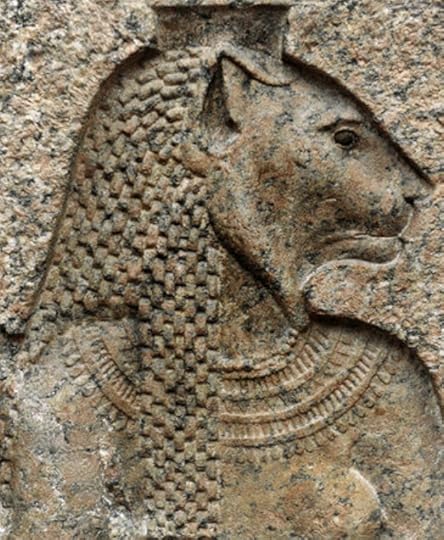 Mehyt
MehytFrom Upper Egypt, there is the story of Mehyt and Onuris. Onuris, the desert hunter, is the consort of the Lioness Goddess Mehyt. His name means something like “Bringer of the Distant One” and Her name means something like “the Full One.” It may relate to Her identification as the Udjat Eye of Horus, that is the full Eye or the full moon. Mehyt, like all Eye Goddesses, is a protective Goddess, and protects both Osiris and Re. She is also a Fierce Goddess wielding arrows or hoards of demons as needed. As Onuris is involved in a hunt for the Eye of Horus, His heart is said to ache for the Sacred Eye, which certainly seems to make The Eye less of a thing to be procured and more of…well…a Goddess to be desired. Mehyt and Onuris were also honored in Lower Egypt; there was a temple to Them at Sebennytos.
There were many local versions of the Distant Goddess theme. Frequently, the raging Goddess goes by one name and the pacified one by another—like Sakhmet/Hathor in the Heavenly Cow. At Hermopolis, the fiery Goddess is Ai or Tai, while the peaceful one is Nehemant. Demotic inscriptions from Herakleopolis, where these Goddesses were also honored, show evidence of a festival of drunkenness for Her, as it seems there may have been for all our Returning Goddesses.
 Tefnut
TefnutInscriptions tell us that “when they are drunk, they will see . . . by means of the vessel” and that people make love before the Goddess and celebrate Her with feasts. From Tebtunis (in the Faiyum), Wenut (Who we met here) is the Raging Goddess and Nehemtua is the Returning One. Nehemant/Nehemtua (and other, similar renderings of Her name) is, predictably, identified with Tefnut, Horit, and Hathor.
Instead of Nubia, Nehemtua has fled to Naunet, the Great Goddess of the Hermopolitan Abyss, and settled Herself within Naunet. Here, we do know why She fled: because Set wants to possess Her, both sexually and as a symbol of His father Geb’s kingdom. So again, the Goddess is fleeing either post-rape or to prevent it. In this tale, it is Thoth and Nephthys Who go to bring the Goddess back.
Upon Her return, Nehemtua is said to have been “initiated” (bsi) to Shu (reinforcing Her connection to Tefnut) in the great (sacred) lake at Hermopolis. Frequently, water is required to cool down the fiery Goddess.
 Temple of Mut with isheru
Temple of Mut with isheruThe Great Goddess Mut, Whose name means simply “mother,” is also associated with this theme. She is the Lady of the Isheru,* the crescent-shaped sacred lake in which the Raging Goddess is cooled and, no doubt, purified upon Her return. Part of Her ecstatic festival of return was called the Navigation of Mut and was enacted upon the cooling isheru. Some semi-recently come-to-light texts have made Mut’s festival of drunkenness rather famous. A very fragmentary text about these festivals refers to “the Distant One” and to pacification of the Goddess. We learn of singing, dancing, drinking, feasting, and “sexual bliss” in honor of Mut. Pharaoh Hatshepsut is recorded as having built a “portico of drunkenness” for Her.
 Mut the Mother, Mut the Daughter
Mut the Mother, Mut the DaughterAlso of note is Mut’s ability to renew Herself; She is both mother and daughter. Her consort is Amun, Who is capable of self-renewal, too, for He bears the epithet Kamutef, Bull of His Mother. And yes, the bull part refers to sex. So we have Mut and Amun (and Re, as possessor of the Eye, is in there somewhere, too) as mother and daughter and son and father to each other. The God Min of Koptos is also called Kamutef—with Isis as His mother/sexual partner. With the Isis-Horus connection so strong, Min eventually takes on the name Horus as well.
And this is by no means the end of the Egyptian Goddesses associated with the myth of the Wandering Goddess, but it is enough to get a picture of its widespread nature. Egyptologists’ explanations for its origins include: the sun’s movement southward from summer to winter; the heliacal disappearance and return of the star Sirius to herald the Inundation; the waning and waxing of the moon during its cycle; the Inundation itself as its waters quench Egyptian fields and cool the red-hot Goddess; the hunter bringing back a tamed animal to his tribe; the maintenance of royal power; the return of ma’et after a period of disorder; and a young woman’s first menstrual period—wherein she leaves as an immature girl, but returns as a sexually mature being, a possibility I find intriguing. Oh, and let’s not forget (in some cases) rape as the reason for the Goddess’ departure and the “sorry, come back home, baby” nature of the persuasions—to put another human face on it. All of these make some sense and there doesn’t have to be just one answer.
As I said in the beginning, we don’t usually connect Isis with this myth. We have no stories left to us in which Isis rages off and has to be persuaded to return, from Nubia or anywhere else. We know of no festivals of drunkenness for Her. And yet, I feel almost certain that there used to be just such a tale. We’ll talk about that next time and I’ll lay out my case.
*As you might guess, Sakhmet and Bast, both feline Deities, were known to have isheru…but Wadjet had one, too. Usually, we think of Her in the form of the Uraeus Goddess, but She also had a lioness form—and is thus among our Fierce and Fiery Felines, too.
January 26, 2025
A Prayer to Isis in a Time of Deep Pain
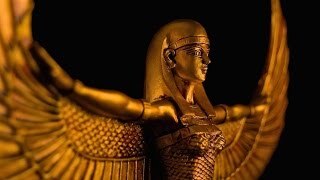
“In the center is a Sanctuary and I am calling you to come inside,” the Beautiful One said in a voice soft as thought.
Outside, pale prophets spoke words of doom, contagious fear spreading from their cold lips.
“Pay it no heed,” says She. “In the Sanctuary, an Incandescent Fire resides. The helpless heart is strong.”
Her words penetrate so close to my shuttered heart that I am afraid to hope. And yet I do hope.
“Enter into Sanctuary, enter into Peace,” She says. “Pain and fear cannot exist within; they are Other. Come now, you are not abandoned.”
Fear begins to fall away into pools of light, white as lightning.
“Look,” says She, “I have woven for you a Chrysalis.”
“I know,” I say, “of Incandescent Fire, and Sanctuary is the entering within.”
The Beautiful One smiles, “Yes.”

Frankly, I do not know how we get through the Horrors with our sanity intact.
I do know that we cannot give up and we cannot give in. We must resist. And we must rest—within the wings of Our Lady Isis and in the presence of all our Divine Ones.

It is a time to take care of ourselves, both our individual selves and our community selves; to ignite and grow an inner reservoir of hope, and even joy. It is not frivolous to dance, to laugh with friends; it is soul-saving. It is powerful to make art. It is powerful to make magic. It is powerful to be in Nature, breathing the breath of the earth and the skies and the waters. It is powerful to reach out to each other, to help and to hold.
To fuel such acts of power, we stay connected—not only with ourselves and our communities, but also with the Divine. We envelop ourselves in that chrysalis of incandescent fire that She has woven from Her own wing feathers for us. It is made of transformations and miracles and strength.
And yes, we must take action. Join groups. Give money if we can. Write letters and call. Nagging can be powerful, too.

As those of you who have been following along with this blog know, its purpose has never been political. And it is not my intention for it to veer off in that direction.
So next time, we’ll return to our regular topics. I am always searching for information about Our Lady that I want to share with you. As well as new ways that we can open ourselves fully to Her, so that She—and we—may discover, nurture, and empower our Isis Hearts within. These are ways we stay in connection with Her.
Her wings uphold us. Her wings enfold us. Now in this time of pain in the presence of evil, and forever.

January 19, 2025
What is Isis Like?
Not what does She like. But what is She like.
I admit, I don’t spend as much time in Her shrine as I would like. (My guilty conscience says, “as I should.”) Yet, since Her shrine and my office are in the same room, She is always there with me, even if I’m not in active communion.
And I will further admit that, even when I am in active communion, I am often seeking inspiration from Her about how to better communicate Her love, power, wisdom, and magic to others who seek Her.
But it’s important for me—as I suggest it may be for you—to just to be with Her, to feel Her presence, to sense Her Being, to drink Her sunlight, to taste Her magic. With no other agenda.
So, I’d like to share a little of what She’s like for me in such times, and invite you to share what She’s like for you, if you wish.
Something I’ve found very interesting over the years is that the experiences people have with Her are so harmonious. Certainly many discover Her as a loving Divine Mother. It’s a form many Goddesses take for us human beings. But I was really struck, one time in particular, when someone I was talking with described Her as “noble,” a word that I have often used to describe Her to myself. Though we are all so very different people, harmonies like that let me know that, yes indeed, we are all touching the same Goddess. We are all feeling Isis. We are all intuiting beneath Her wings.
So what is She like?
As She arrives, Isis is like the rumble of thunder just after the lightning flash. I feel Her move in the sky above me, in the earth beneath me. I feel Her thunder deep in my belly, in my womb.
Isis is like the face I can’t quite see beneath an obscuring veil. For a moment—a bright moment—She shows Herself to me. And for that instant, I think I know something about Her. And then Her veil is drawn back into place, endarkening Her aspect once more. O, I love that about Her. She makes me want Her.
Sometimes, Isis is like the earth after rain, when the sun comes out suddenly and mist wisps through the grasses in the unexpected heat. Then Isis is like the late-summer sun warming the heart in my naked body. She claims Her Iset Ib, Her Isis-Heart, that is within me.

Isis is like the tears shed for me, shed for the Lost One, shed for all of us. I place myself in Her hands when I am in sorrow and She hears me.
O yes, Isis is noble, Her head uplifted. In turn, She uplifts my face in Her hands that I may look into the profound depths of Her eyes. I see there unending strength and wisdom and love and magic. She makes me aspire to all those things, though I know I am ever-so human.
Isis is sun-golden. Isis is underworld-black. Isis is star-white. Isis is serpent-green. Isis is lapis lazuli-blue. Isis is blood-red.
Isis is like the Mystery that can never be fully described. Her great wings encircle, enfold, illuminate. Each feather is a teaching. Each feather is a world. I feel Her wings brush me softly and I swoon. Her Mystery upholds me, shows me, seduces me.
Isis is the most ancient, ancient. Unknown and untouched are Her depths. She calls me. She captures me. She floods me. She fills me.
And sometimes, just sometimes, that is what Isis is like for me. What is She like for you?
January 12, 2025
Isis & the Sorcerer’s Apprentice

Did you know that the famous tale of the Sorcerer’s Apprentice is an Isis story?
Yep. And She is in Her guise as Great Magician—and a teacher of magicians.
The version you may be familiar with is Disney’s retelling of the tale with Mickey as the apprentice from the animated movie Fantasia. Before that, it was popularized by Johann Wolfgang von Goethe in a 14-stanza poem called Der Zauberlehrling.
But that’s not where it originates. The oldest-known version of this tale is from a 2nd-century CE book by Lucian of Samosatos, a Hellenized Syrian known for his satires, rhetoric, pamphlets—and his snarky style. His snark is on full display in his book of dialogs called Philopseudes, or “Lover of Lies,” in which we find the tale of the Sorcerer’s Apprentice.
The book begins with the character Tychiades asking why people are so fond of “lies.” (Tychiades means “son of Tyche;” Tyche is the Goddess of Fate and Fortune and She was assimilated with Isis in this time period; there is even an Isityche.) The lies to which he refers are the “superstitious” remedies people are suggesting for a mutual friend, Eukrates, who has fallen ill. This situation serves as a framing story for ten tales of magic and the miraculous that the gathered friends, many philosophers, tell in order to convince Tychiades that the supernatural is not a lie.
 An illustration for Goethe’s poem
An illustration for Goethe’s poemLucian seems to have favored the tale of the Sorcerer’s Apprentice as he gave it the most space of any of the included ten tales, and he placed it last to serve as the climax of the entire book. This story Tychiades hears from Eukrates himself.
Eukrates explains that the events he is about to relate are his very own experiences and that when Tychiades hears him out, he will be persuaded of the truth of the tale.
Eukrates story takes place in Egypt, as many ancient tales of magic did. As a young man, Eukrates has been sent on the Grand Tour throughout the Mediterranean world by his father to further his education. He is traveling up the Nile on his way to Koptos, and from there he intends to travel to the Colossoi of Memnon. Ahh, but he never makes it there.
For during his Nile travels, he meets a learned Egyptian scribe. I’ll quote the book now, because this is the part where we find Isis.
“We happened to be accompanied on the voyage up the Nile by a man of Memphis, one of the sacred scribes. His wisdom was marvelous and he had had the full Egyptian training. It was said that he had lived underground for twenty-three years in crypts while being trained in magic by Isis.”
“You’re speaking of Pankrates,” said Arignotus, “He was my teacher: a holy man, always shaven, thoughtful, speaking his Greek with a heavy accent, long and thin, snub-nosed, with protruding lips and rather skinny legs.”
“Yes, that’s Pankrates!” he said. “At first I didn’t know who he was, but when I saw him performing all sorts of miracles every time we put to, most notably riding on crocodiles and swimming with the animals, whilst they fawned upon him and wagged their tails, I realized that he was a holy man, and by being nice to him I became a friend and comrade by gradual and imperceptible stages. As a result, he shared all his secrets with me. Eventually he persuaded me to leave all my servants behind in Memphis, and to accompany him, the two of us on our own. For, he explained, we would not want for attendants. This is how we lived thenceforth.”
And so we learn that the great holy man, Pankrates, was a fully trained Egyptian scribe magician—and trained by our Lady of Magic Herself. Thus, he is capable of all the classic Egyptian magician feats, from riding crocodiles to taming wild beasts. He could probably understand the language of animals, too.
 Another illustration of Goethe’s poem
Another illustration of Goethe’s poemAs it turned out, it was quite true that Pankrates and Eukrates did not need any servants. For anytime a task needed doing, Pankrates would take a broom or pestle, bring it to life, and it would do the task perfectly. Interestingly, Eukrates notes that the transformed broom “would look human to everyone else;” something Disney left out because living brooms were way more fun to animate, no doubt.
Of course, the power to create magical servants (ushabtis?) was the power Eukrates most craved and it was the one thing Pankrates withheld. But one night, Eukrates eavesdropped on his master and overheard the first part of the incantation—the part that could turn a broom into a person. But he never learned the second part: how to turn the servant back into a broom.
You know the rest of the story. Water, water, everywhere.
In the end, the holy man returns, restores order, then promptly disappears—giving the hapless Eukrates no further information or instruction.
 Mickey screws up
Mickey screws upAt the conclusion of his tale, one of Eukrates’ friends asks whether he can still conjure magical servants. Oh yes, indeed, Eukrates answers. But he still doesn’t have the off-button and so he’d wreck his home if he actually did the magic.
In an article I’m reading about this, the author compares the story of the Sorcerer’s Apprentice with a number of other magical tales. Some are Greek, some Egyptian. All share an Egyptian setting, an ambitious young man, a search for magical knowledge, a venerable magician-priest, and often a magical book. You can read about just such an Egyptian tale here and here.
The point he makes is that the Sorcerer’s Apprentice isn’t an outlier tale as some scholars of Lucian have long suggested. Instead, it fits well within a genre of Egyptian-magic-focused tales that were very popular at the time. This is also the time period during which the worship of Isis had spread widely throughout the Mediterranean world.
For me, the enduring popularity of this tale is just another example of the extremely significant influence ancient Egypt—and our Lady Isis (for Who else could be the Great Teacher of Magicians?)—had upon their neighbors.
January 5, 2025
Being a Servant of Isis—Outward Signs & Inner Experience
 A servant of the Goddess shakes the sistrum
A servant of the Goddess shakes the sistrumMany of you who read this blog may have a special relationship with Isis; you may be Her priestess or priest. And perhaps you, like me, have also been searching for a gender-neutral term for that special relationship. Some in our community have adopted “priestex” based on other contemporary gender-neutral endings.
I can offer you an option from ancient Egypt as well.
Now, ancient Egyptian was a highly gendered language: Goddess—Nudjeret; God—Nudjer. As in English, where we might add -ess to feminize a word, they added “t” to the end of the word to indicate the feminine. Most Goddess’ names, in Egyptian, end in “t.” (We usually add an “e” before the “t” to make it pronounceable as in Amun/Amunet.) The Egyptian titles that we translate as priest or priestess are hem (masc.) or hemet (fem.) Nudjer/Nudjeret. More literally, these are translated in English as “servant of the God/dess.” Since “servant” has no gender in English, servant of Isis is a perfectly good, gender-neutral term for this special relationship.
 Sarcophagus lid of a priestess of Isis from Carthage
Sarcophagus lid of a priestess of Isis from CarthageWhatever title we may prefer, the relationship itself comes with responsibilities. However, unless we are part of a formal organization that specifies what those responsibilities are, each of us will have to decide for ourselves exactly what serving Isis means to us. For me, there are five main keys, which I’ve written about on this blog—from worship and gaining knowledge about Her to ritual competency and spiritual growth.
When trying to sort out decisions like these, I often look to the past. Is there anything we can learn from the experiences of ancient servants of the Goddess? Of course, we have some information about what was required of them within the temples. But what was going on in their heads and hearts?
Unfortunately, we have little left that tells us what it meant to them inwardly and spiritually. No doubt, some servants were more devout than others. Nonetheless, there is every reason to think that indeed there were inner experiences. The Egyptian reputation for religious and philosophical knowledge was immense. It would only make sense that those who were sincerely following their path would have important personal, spiritual experiences—just as people have always done.
Though records of these inner experiences are few, we do have hints. For instance, from the the reign of Thutmose III we have an inscription that indicates that priestly initiations meant something spiritually as well as professionally. A new royal vizier, who was made Prophet of Ma’et*, says of his experience:
My abilities were not as they had been: my yesterday’s nature had altered itself, since I had come forth in the accouterments of a vizier, having been promoted to be Prophet of Ma’et.
 A servant of the God
A servant of the GodThis man felt truly changed by “coming forth” as a vizier and servant of Ma’et. We can assume that at least some of the servants of Isis had no less an experience than this man. Thoth also seemed to inspire warm feelings in His devotees—and as many of them were scribes, they had the ability to express it. They called Him the Lord of Friendliness and the God of Incomparable Goodness.
As late as the Greek Magical Papyri, this friendliness with Thoth remains. In PGM VIII, 1-63, Thoth is called Hermes, but we can known He is Thoth because the spell says that His images include an ibis and a baboon, that His name is great in Hermopolis (Khmunu; “City of the Eight”) and that even Isis, “the greatest of all the Gods,” calls on Him in every crisis. Part of the spell states, “For You are I, and I am You; Your name is mine, and mine is Yours. For I am Your image.” While the magic here is powerful, the sentiment is gentle and intimate.
In what is today known as the Archive of Hor, we have some records of intimate feelings for the Goddess. Hor was a priest of Isis and Thoth who came from the town of Sebennytos, the town that grew up around the Temple of Isis there, and which the Greeks called Isiopolis. He writes beautifully of Her, has prophetic dreams from Her, and calls Her by what I think is a pet name, “my Tana.” You can read his story here.
 Priest of Isis holding Osiris Hydreios
Priest of Isis holding Osiris HydreiosYet the closest thing we have to a personal account of spiritual experiences related to Isis is in a novel by a North African named Apuleius. They are in his book, The Golden Ass, and he writes about his initiation into the Mysteries of Isis.
It dates to the late second century CE, when Isis’ popularity was most widespread. Because it is novelized, it gives us a glimpse of the protagonist Lucius’ interior state. And while Lucius is an initiate of Isis and not a priest, one could make an argument that he would probably qualify as what we would call a priest of Isis today. He is an initiate, he remains involved with the religion—serving in its special ranks or grades—and he outwardly marks himself as an Isiac by shaving his head.
In the novel, Lucius has had a spiritual crisis. After being magically turned into an ass, he has gone through trials and tribulations and finally throws himself upon the mercy of the Moon Goddess. She reveals Herself as Isis. She says that though She is called by many names, Her true name is Queen Isis.
She tells Lucius not to fear:
But above all things beware thou doubt not nor fear of any of those things as hard or difficult to be brought to pass…
…and know this of certainty, that the residue of thy life until the hour of death shall be bound and subject to Me; and think it not an injury to be always serviceable towards Me whilst thou shalt live, since as by My means and benefit thou shalt return again to be a man. Thou shalt live blessed in this world, thou shalt live glorious by My guide and protection, and when after thy allotted space of life thou decendest to the Underworld, there thou shalt see Me in the subterranean firmament shining (as thou seest Me now) in the darkness of Acheron, and reigning in the deep profundity of Styx and thou shalt worship Me as one that hath been favorable to thee. And if I perceive that thou art obedient to My commandment and hold to my religion, meriting by thy constant chastity My divine grace, know that I alone may prolong thy days above the time that the Fates have appointed and ordained.”
As an initiate of Isis, Lucius’ life is to change. He is to be Hers forever; and in return, She will not only save him from his present difficulty, but prolong his lifespan.
 Roman priestess of Isis
Roman priestess of IsisThe priest who is overseeing his initiation tells Lucius that to take Isis’ holy orders was like a “voluntary death and slow recovery.” Yet, even if someone were on the edge of death, and had but the strength to receive Her Mysteries, that person could be made new-born and healthy once more. He advises Lucius to “accept of your own free will the yoke of service.”
The mental and emotional state of Lucius after his initiation is one of pure love and wonder. He is passionately in love with the Goddess—and he remains so throughout all the days of his life.
I’ve had an experience like that. And I have always remembered it. It is one of the many experiences with Her that has made me passionate in my love of Her and dedication to Her.
Have you had such an experience?
* I’m only looking at a translation here and don’t have the Egyptian. When Egyptologists translate “prophet,” they usually mean a high priest, thus this title may have been Hem Ma’et Tepi or chief servant of Ma’et.



